


|
|

|
Advanced Fisheries Management Information System
REAL-TIME FORECAST
DEMONSTRATION OF CONCEPT PLAN
Georges Bank: 15 March - 15 April 2000
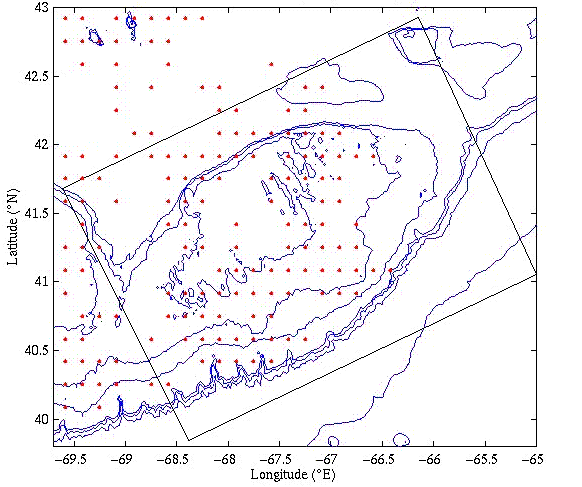
|
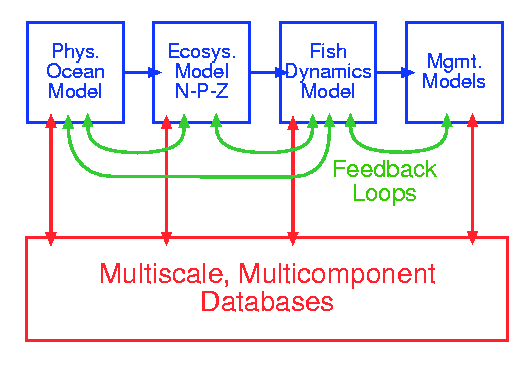
|
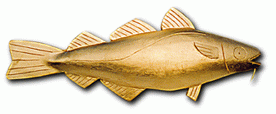
|
Brian J. Rothschild
Lead Principal Investigator - CMAST
Allan R. Robinson
Principal Investigator - Harvard, Demonstration Chief Scientist
Merlin Miller
Principal Investigator - Physical Sciences, Inc.
Hyun-Sook Kim
Editor - CMAST
Wayne G. Leslie
Editor - Harvard
NASA --- ONR
Table of contents
Preface
Appendix 1 - List of Acronyms
Appendix 2 - Hypotheses, research issues, concepts and processes
Preface
The Advanced Fisheries Management Information System (AFMIS) is intended to apply state-of-the-art multidisciplinary and computational capabilities to high-frequency operational fisheries management. The system development concept is aimed toward: 1) utilizing information on the "state" of ocean physics, biology, and chemistry; the assessment of spatially-resolved fish-stock population dynamics and the temporal-spatial deployment of fishing effort to be used in the operational management of fish stocks; and, 2) forecasting and understanding physical and biological conditions leading to recruitment variability. Systems components are being developed in the context of using the Harvard Ocean Prediction System to support or otherwise interact with the: 1) synthesis and analysis of very large data sets; 2) building of a multidisciplinary multiscale model (coupled ocean physics/N-P-Z/fish dynamics/management models) appropriate for the northwest Atlantic shelf, particularly Massachusetts Bay and Georges Bank; 3) the application and development of data assimilation techniques; and, 4) with an emphasis on the incorporation of remotely sensed data into the data stream.
This nowcasting and forecasting exercise is intended to demonstrate important aspects of the AFMIS concept by producing real time coupled forecasts of physical fields, biological and chemical fields, and fish abundance fields. Forecasts in three spatial dimensions of ten days duration will be produced once a week for a month. It is intended to verify the physics, to validate the biology and chemistry but only to demonstrate the concept of forecasting the fish fields, since the fish dynamical models are at a very early stage of development. In addition, it is intended to demonstrate the integrated system concept and to consider the implication of coupling a management model. A ten day duration forecasts was chosen to shorten the management decision times and to lengthen fishing boat planning times. Since weather forecasts are not at all reliable after five days, the second half of the physical forecasts will reflect only internal sea dynamics.
The Advanced Fisheries Management Information System (AFMIS) will apply state-of-the-art multidisciplinary and computational capabilities to fishing and fisheries management. AFMIS is unique for several reasons. Coupled physics and biochemical dynamics has been previously accomplished. The addition of fish dynamics provides a new and potentially very valuable capability. AFMIS is designed to model a large region consisting of most of the North West Atlantic. Several smaller domains, including the Gulf of Maine and Georges Bank are nested within this larger domain. This provides a capability to zoom into these domains with higher resolution while maintaining the essential physics which are coupled to the larger domain. AFMIS will be maintained by the assimilation of a variety of real time data. Specifically this includes sea surface temperature (SST), color (SSC), and height (SSH) obtained from several space-based remote sensors (AVHRR, SeaWiFS and Topex/Poseidon). The assimilation of these data will allow nowcasting and forecasting over significant periods of time.
This document provides a detailed plan for a first demonstration of a complete AFMIS. The goals are 1) to demonstrate real-time nowcasting and forecasting of coupled physical, biochemical and fish distribution fields on Georges Bank for a period on the order of 1 to 2 weeks and 2) utilize the data obtained to produce information relevant to fisheries management. These goals are based on several hypotheses, including the assumption that a dedicated ocean prediction system (AFMIS) which properly incorporates the interaction processes and feedback between the three dynamics can nowcast and forecast state variables of interest and that fish abundance distributions vary over 1 to 2 week time scales in ways that are important for fisheries management and fishing. The demonstration of concept (DOC) has been structured to directly address these hypotheses by providing results in near real time to a variety of users.
This DOC is scheduled for the time period from about 15 March 2000 to 15 April 2000. During this 1-month period, forecasts will be issued on a weekly basis. Each of these forecasts will provide prediction of the various fields for the subsequent ten days.
The specific products which will be issued include the following:
· Synoptic maps at three levels (surface, mid-level, bottom) at 1200 local time for: temperature, salinity, current speed (sub-tidal), velocity vectors (sub-tidal), Herring abundance, Cod abundance, chlorophyll, nutrients, zooplankton and surface-bottom velocity difference (sub-tidal).
· One map containing plots of total (tidal and sub-tidal) velocity
· Daily mean surface plots of total (tidal and sub-tidal) velocity
· Daily mean surface circulation, with overlying temperature, at 1200 local time
· Two vertical sections (along Georges Bank and across the bank) of temperature and velocity
· Daily mean circulation (sub-tidal) at two levels (surface and bottom) for the Gulf of Maine domain.
Other products may also be issued if warranted and of interest to the user community.
A number of technical tasks must be accomplished prior to the DOC. The coupled physical and biochemical models are available but need to be tuned to the March/April conditions on Georges Bank. Additional work on the fish dynamics model is required prior to its full integration. Some details of the nesting procedures also require additional development.
Data required to support AFMIS are obtained from a number of sources, generally via the Internet. Protocols for the collection of satellite data (SST, SSC, and SSH) and other data have been specified and individually tested. Quality control and preparation procedures have been specified.
All models will be fully developed and integrated by 1 January 2000. Starting in October, a number of Observation System Simulation Experiments (OSSE) will be accomplished to test several critical aspects of AFMIS. These will include:
· New real-time data acquisition
· Data quality control/preparation and analysis of gridded fields
· Calibration of physical and numerical parameters
· Product generation.
Given success with these OSSEs, pre-operational forecasting will be started about 15 February. This will provide experience with real-time operation and allow procedures and operations to be optimized prior to the actual DOC.
Upon completion of the DOC, a critical evaluation of the results will be undertaken. The objectives of this activity will be to assess the operational aspects of AFMIS, determine the utility of the products and to identify modifications to models and/or procedures which will optimize performance and enhance the utility of AFMIS.
Goals:
Specific scientific and technical objectives:
Real-time system should include:
Schedule
The AFMIS Real-Time Demonstration of Concept (RTDOC) is scheduled for the nominal time period 15 March - 15 April 2000. This one-month long time period will have four (4) forecast issue dates. Ten day long forecasts will be issued on a weekly basis. The first "internal trial" forecast (with a nowcast of 15 March and a first day forecast of 16 March) will be available for evaluation late in the day on 15 March. Actual forecast issue dates will be 22 and 29 March and 6 and 13 April.
The AFMIS operational system should be in place by 1 January 2000. This provides a six-week time window in which to identify and repair problems which may occur in the model system. This schedule also allows for time to modify operational protocols based on the synoptic oceanographic conditions, logistical considerations and OSSE results.
Products
CMAST will be the site from which AFMIS operational products are distributed. The methods by which the products will be released are: a web site based distribution, email summaries to identified users and fax. Overnight delivery of hardcopy will be sent to critical persons, while standard US mail delivery (2-3 days) will be utilized for other recipients. The standard operational products for the Georges Bank region will be issued for a ten-day period with products on a daily basis during that period. The products will include:
Some example products for a Georges Bank forecast can be found below.
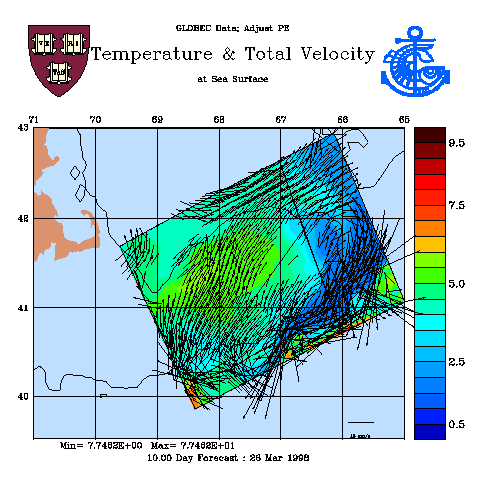
|
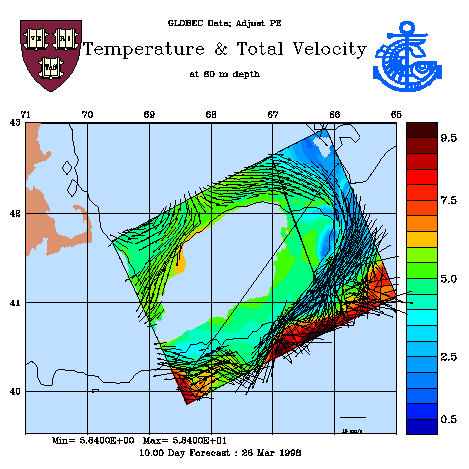
|
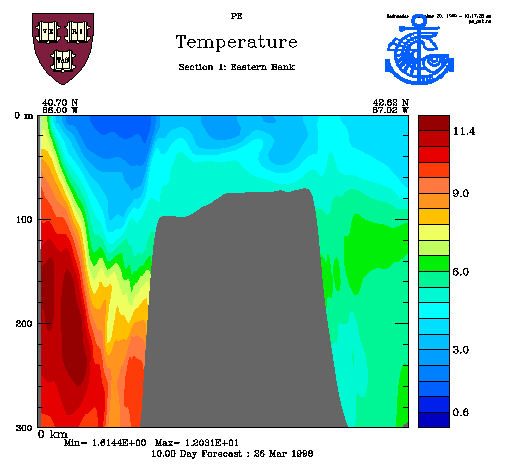
|
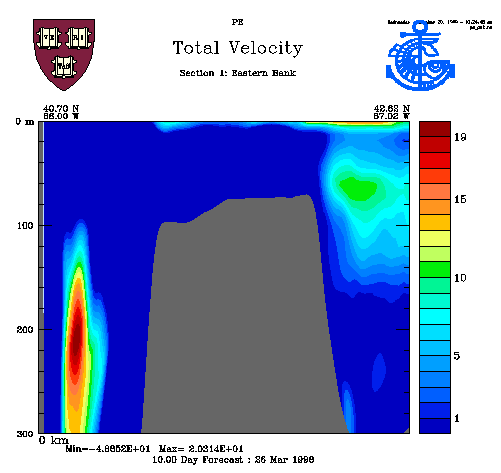
|
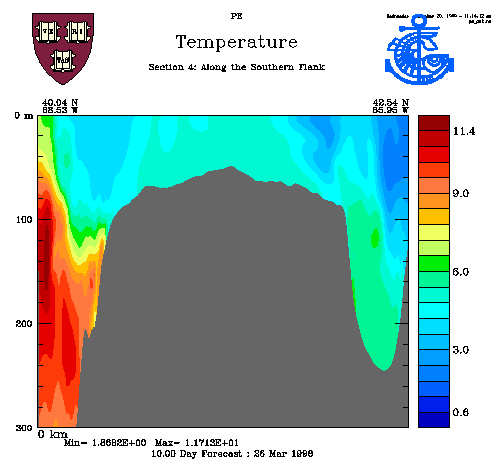
|
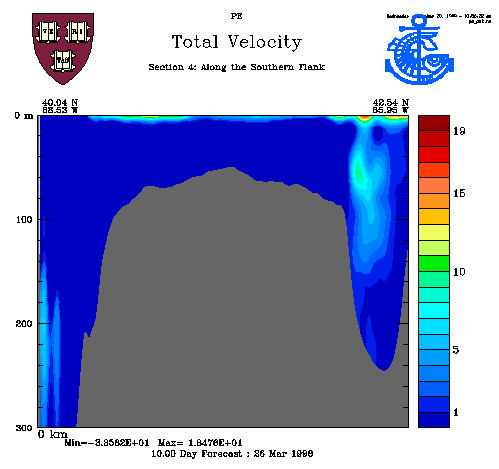
|
Protocols
Basic Operational Protocol
The central dynamical models for the AFMIS RTDOC are contained with the Harvard Ocean Prediction System (HOPS). HOPS (see Figure 1a) is a flexible, portable and generic system for inter-disciplinary nowcasting, forecasting and simulations. HOPS can rapidly be deployed to any region of the world ocean, including the coastal and deep oceans and across the shelfbreak with open, partially open or closed boundaries. Physical, and some acoustical, real time and at sea forecasts have been carried out for more than fifteen years at numerous sites and coupled at sea biological forecasts were initiated in 1997. The present system is applicable from 10m to several thousand meters and the heart of the system for most applications is a primitive equation physical dynamical model. Work is in progress to extend the system to estuaries and to include a non-hydrostatic option. Multiple sigma vertical coordinates have been calibrated for accurate modeling of steep topography. Multiple two-way nests are an existing option for the horizontal grids. The modularity of HOPS facilitates the selection of a subset of modules to form an efficient configuration for specific applications and also facilitates the addition of new or substitute modules. Data assimilation methods used by HOPS include a robust (suboptimal) optimal interpolation (OI) scheme and a quasi-optimal scheme, Error Subspace Statistical Estimation (ESSE). The ESSE method determines the nonlinear evolution of the oceanic state and its uncertainties by minimizing the most energetic errors under the constraints of the dynamical and measurement models and their errors. Measurement models relate state variables to sensor data. Real time efficiency is achieved by reducing the error covariance to its dominant eigendecomposition.
During the demonstration of concept exercise, HOPS will be operated in two modes: operational and research operational. The operational mode consists of well-tested models and procedures. The research operational mode consists of models and procedures which are under development and/or require additional tuning. In operational mode, the HOPS physical (primitive equation) model will contain: a rigid lid approximation, 2-way, 2-level nesting, atmospheric forcing, an external tidal model (with a backup regional tidal mixing model), and riverine input. In research operational mode, potential new features include: a free surface approximation and 2-way, n-level nesting (n=3).
Coupled Physical/Biological/Fish Dynamical Forecast Protocols
Coupled physical/biological/fish-dynamical models are used to provide weekly issued 10-day forecasts (see products section) for a one-month period. These simulations will, largely, be maintained with remote sensing:
The weekly forecasts will be supported by more frequent tuning, testing, and debugging runs.
The biogeochemical/ecosystem model used will be a simple six-compartment (nitrate, ammonium, phytoplankton biomass, phytoplankton chlorophyll, zooplankton and detritus) ecosystem model. Trophic interactions are described schematically in Figure 1b. Phytoplankton productivity is modeled using a simple two-parameter photosynthesis-irradiance model. The irradiance field is modeled using a simple exponential attenuation model, with a chlorophyll dependent attenuation coefficient. With the exception of chlorophyll, all ecosystem compartments are nitrogen-based. Chlorophyll concentration and the nitrogen-based phytoplankton biomass are treated here as separate state variables; this allows incorporation of photoacclimation kinetics into the model framework. Several "optional" model configurations are available, including a spectral irradiance model coupled with a pigment-specific absorption based productivity model. In addition, detrital effects on light attenuation can be modeled explicitly (in the scalar irradiance model) using a detritus-specific attenuation coefficient.
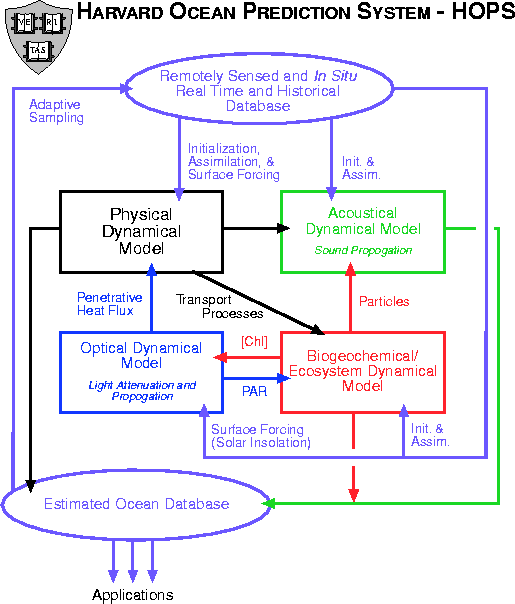
|
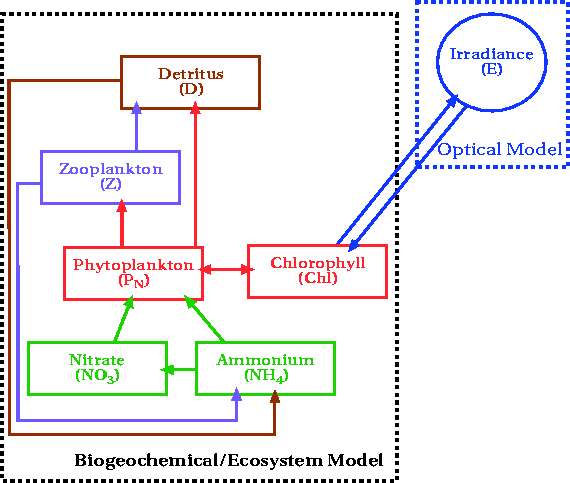
|
Figure 1 - a) Harvard Ocean Prediction System (HOPS), b) Biogeochemical/Ecosystem Model component of HOPS
Work is in progress in the formulation of the fish dynamics model component of the coupled model system. Initially the focus is on two fish populations: cod and herring. The state variables to be modeled and predicted are the abundances (mass densities) of life stages (or size classes) of selected species as functions of three dimensional space and time, hereafter referred to as fish fields. The space-time resolution of the fish fields is, of course, dependent upon the specific problem under investigation. The field equations for the fish variables conserve the abundances, taking into account sources (birth, metamorphosis, growth) and sinks (predation, death, metamorphosis), advection and behavior (vertical and horizontal swimming). Swimming behavior includes seeking favorable environmental parameters (e.g. temperature preference, location in the water column) and food, spawning and avoidance of predators. Density dependent dispersal of individuals is modeled statistically as a diffusive process acting upon the fish field, i.e. a flux down the gradient of the abundance. Seeking favorable conditions in response to the distribution of another field variable to which the fish are attracted is modeled as a flux up the gradient of the attractor.
A two-way nested model consists of a dynamical model defined in two domains, one with coarser resolution containing the other with finer resolution. Information from the finer resolution domain, properly averaged, is used to replace information in the coarser resolution domain areas intersecting with the finer resolution domain (up-scale). Information from the coarser resolution domain around the boundaries of the finer resolution domain is used, properly interpolated, to improve boundary information in the finer resolution domain (down-scale).
The operational system will consist of three nested domains: the Northwest Atlantic (NWA), the Gulf of Maine (GOM) and Georges Bank (GB). The specifics of the individual domains are given in Table VI-7 and the domains are shown in the figure below. In the operational context, there will be two-way nesting between the NWA and GOM (NWA/GOM) domains and the GOM and GB (GOM/GB) domains. The NWA/GOM nested run will provide boundary conditions for the GOM during the GOM/GB nested run.
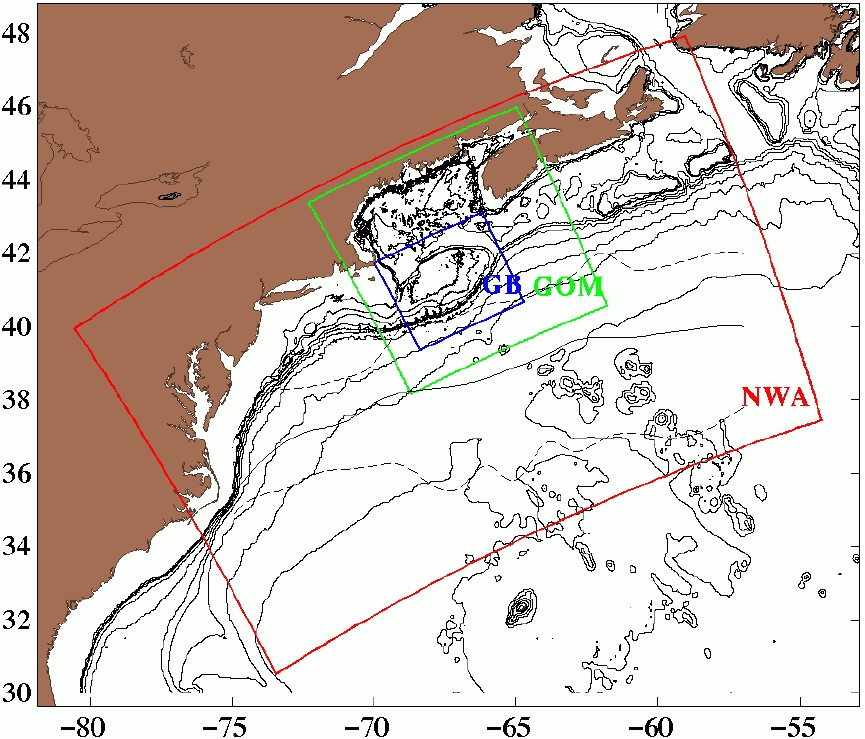
Nowcast/Forecast Plans
Multiple model forecasts are required to produce each issued forecast. The update of the forecast is done in two stages. First a hindcast is done to bring the atmospheric forcing and assimilation up to date. Then a 12-day simulation is performed to produce the desired 10-day forecast fields. The separation of the hindcast and forecast simulations maximizes the use of the most recent atmospheric forcing data/forecasts. The nested pair runs are staggered, with the NWA/GOM hindcasts/forecasts being done on the work day previous to the GOM/GB runs. This plan is based on the following assumptions:
-- This needs to be checked ASAP.
-- This needs to be checked, especially the negligibility of adding nesting.
Graphically, the forecast plan is illustrated by the following time-line:
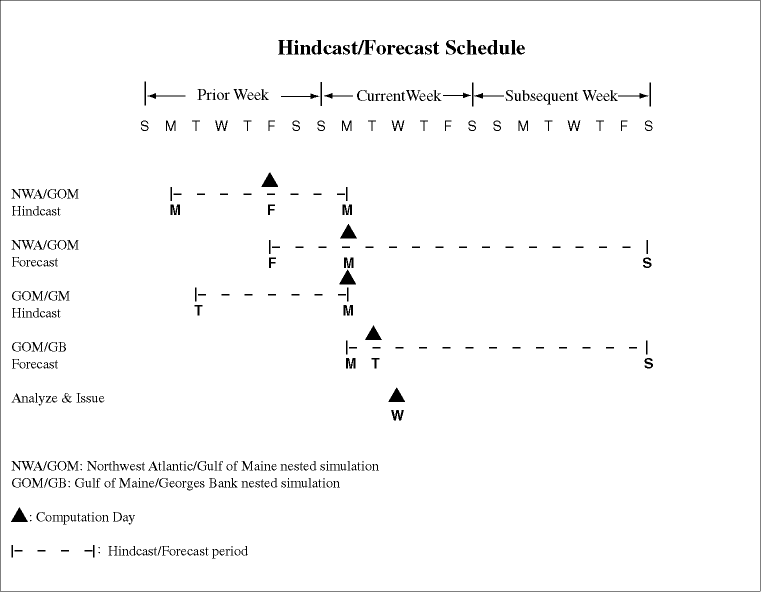
The GOM/GB forecast is actually a pair of runs. The first is a coupled physical/biological/fish dynamical model with complete data saved daily. The second is a physical model with sparse velocity data saved on quarter tidal cycles to save space.
Assimilation Plans SST
SST observations are gridded in cloud-free regions. This gridded data is then sub-sampled to contain ~200 profiles within the domain of interest. The surface values are assumed to be representative of the complete mixed layer and vertical profiles of temperature are constructed from the temperature values.
SST will be assimilated in all 3 domains (NWA, GOM, GB). Only SST fields from reasonably cloud-free (~2/3 of the domain) days will be assimilated. For March-April this will probably mean around 2 assimilation fields per week per domain. Ramping will be done to get the data in within 1 day of the actual time.
SST Assimilation Ramping
|
Days in Advance |
0.75 |
0.25 |
|
Weight |
0.5 |
0.99 |
SSH
Satellite SSH anomalies received from Colorado State University are complemented with estimates of the mean SSH elevation to obtain estimates of absolute SSH. Large scale and mesoscale SSH signals are separated, and the SSH mesoscale synoptic signal is assimilated into the model, vertically projecting the surface information as temperature and salinity profiles into the water column.
SSH will be assimilated in NWA domain only. Assimilations will occur once or twice a week, depending upon the weekly coverage. Ramping will be done over 2 days. This longer time reflects the expected longer decorrelation time scale of the deep data.
SSH Assimilation Ramping
|
Days in Advance |
1.75 |
1.25 |
0.75 |
0.25 |
|
Weight |
0.2 |
0.667 |
0.875 |
0.99 |
SSC
Sea surface color will be assimilated (via initialization) into the model chlorophyll fields. Chlorophyll values from SeaWiFS are used to dictate the values in the model surface layer. These are then extended throughout the mixed layer. Below the mixed layer, chlorophyll values are relaxed to a negligible background value.
SSC will be assimilated in GB domain only. Only SSC fields from reasonably cloud-free (~2/3 of the domain) days will be assimilated. For March-April this will probably mean around 2 assimilation fields per week per domain. Biological fields will have to be adjusted to physical fields.
-- Start from a relevant, previously created hindcast.
-- Adjust velocities from frozen TS fields (might not be necessary).
-- Adjust NPZ from frozen physical fields.
These adjustments will have to be done as soon as the SSC data are available. Because of the delay in getting SSC (~2 weeks), this will require additional hindcasts to bring fields up to date. Ramping will be done to get the data in within 1 day of the actual time.
SSC Assimilation Ramping
|
Days in Advance |
0.75 |
0.25 |
|
Weight |
0.5 |
0.99 |
The SST and SSC assimilation ramping time scales may have to be accelerated. It might prove necessary to assimilate the data only during the proper portion of the tidal cycle.
Data Protocols
Collection
![]() Atmospheric Forcing
Atmospheric Forcing
° FNMOC fields will be collected at least twice daily.
-- CMAST is already doing this.
° Meteorological buoy data will be collected at least daily.
-- CMAST is developing an automated capability for doing this.
![]() Satellite
Satellite
° SST will be collected at least daily.
-- CMAST is already doing this.
° SSC will be collected at least daily.
-- CMAST is already doing this.
° SSH will be downloaded from Colorado at least daily.
° Fronts and Eddies analyses will be performed daily
-- CMAST has the collection capability.
![]() in situ
in situ
° If any in situ data becomes available, it should be collected immediately.
Quality Control
° Bad data values (land, clouds) need to be identified and flagged.
-- CMAST has this capability for its image products.
temperatures.
-- Under development.
° Bad data values (land, clouds) need to be identified and flagged.
° Regions of reliable SSH need to be determined and the data from those regions selected.
if necessary.
° The local curvature in the frontal locations is smoothed by filtering.
-- Harvard has the necessary software
° Comparisons with meteorological buoy data need to be checked.
Preparation
° Need to be extended with climatological fields.
-- Set climatological fields sufficiently far in future (~20 days) so model "relaxes" about halfway between last forecast and climatology.
shortwave radiation. Interpolate to model grids.
° Extend as constant profiles to the base of the mixed layer.
-- Estimate mixed layer depth from:
. FNMOC fields
. Previous model runs
° Smooth SSC fields and sub-sample so data set will contain ~200 profiles (small enough to
be objectively analyzed).
° Construct first guesses for remainder of biological fields from statistical correlations.
° Adjust biological fields from frozen physical fields.
Use Lozano's EOF procedure to adjust Gulf Stream FM fields in accordance with SSH.
Gridding
OA scales (GB Assimilation Tests)
|
Spatial Zero Crossing (km) |
Spatial Decay (km) |
Temporal Decay (days) |
|
|
Synoptic |
60 |
12 |
1 |
|
Mean |
200 |
80 |
1000 |
Logistics
° GOM/GB nested models run on fastest CMAST computers
This section describes OSSEs to be conducted in order to improve overall system performance; to calibrate multidisciplinary models and operational protocols; to understand sensitivities; and to identify significant and critical parameters and procedures as related to the overall quality, accuracy and timeliness of real-time operations for the Spring 2000 AFMIS demonstration of concept.
The observation system is first defined in terms of the specific datasets, models and procedures to be used in the OSSE. This activity will be performed on the operational system components after their development test and initial tuning for this system. Other research activities that might impact into the scope and performance of the operational system are not considered in this document. An initial description of the operational system is given below. Each experiment will focus on addressing or testing 2-3 technical issues and assessing model performance and quality of output. The major elements of the ocean prediction and simulation system assemble for the demonstrations of concept, together with some major requirements are as follows:
Design
The OSSE design includes: A) Identification of operational system components (what is being tested); B) Description of real-time operations (how it supposed to work); C) Description of the experiments to be carried out (what tests are needed); and D) Execution: work tasks and schedule (how and when).
C) Experiments
i) Near real-time acquisition
The activities under this heading will not be tested during the OSSE.
Data sets for initialization, assimilation, forcing and verification will be for the period of March 15 - April 15 1998.
ii) Data quality control / preparation and analysis of gridded fields.
Data preparation for models.
Experiment II.1 - Calibration of gridding parameters. Physics-Biology
Experiment II.2 - Construct initialization for physics and biology for 3 different configurations, using AVHRR combined with SeaWiFS to identify frontal positions. Adding complexity in each configuration. Integrations in model space to equilibrate biology.
Experiment II.3 - Calibration of gridding parameters. Fish. The final fields should be either close to equilibrium (near Z and comfortable T environment) or far from equilibrium with respect to one of the attractors. Integrations in model space to equilibrate fish distributions.
iii) Data driven forecasts
OSSE should be carried out only after initial tuning of the models and procedures involved. The term calibration should be understood below both, calibration and understanding sensitivity to a relevant set of parameters.
Experiment III.1 - Calibration of physical parameters and numerical parameters. The aim of this experiment is to obtain adequate representation of the following processes:
Large-scale circulation (including tidal residual circulation); (nesting, boundary and Shapiro parameters, tidal parameters)
Vertical mixing (including tidal mixing and wind mixing); (vertical viscosity and diffusivity parameters)
Frontal positions (dependencies on feature model derived fields, vertical mixing parameters)
Tidal advection (diurnal); (tidal parameters)
Experiment III.2 - Calibration of biological parameters and numerical parameters. The aim of this experiment is to obtain adequate representation of the following processes:
Large-scale PZ distribution (dependencies on initial and assimilation fields, u, nesting, boundary and Shapiro parameters)
Distributions of vertical structures of PZ (dependencies on biological parameters, w, mixing parameters)
P/Z ratios and productivity indices (dependencies on biological parameters)
Experiment III.3 - Calibration of fish parameters and numerical parameters.
Bank-scale fish distribution (dependencies on initial and assimilation fields, u, nesting, boundary (export-import) and Shapiro parameters)
Distributions of vertical structures of fish (dependencies on fish parameters, w, mixing parameters, vertical PZ distributions, T distribution)
Swimming behavior as parameterized by up/down-gradient diffusion in temperature and zooplankton concentrations
iv) Products
Experiment IV.1 - During OSSE; generate prototype products in a real-time mode to secure timely flow of the information, and if appropriate feedback from potential end-users.
Execution.
We plan to commence the OSSE's the first week of October 1999 and anticipate having tested the complete system by the last week in January 2000. Software is expected to be finalized by 1 January. Recall that models/procedures are required to have being initially tuned for the area before OSSE experiments commence.
In order to test each of the above system components, a progression of experiments will be conducted. Since the biological and fish modeling are likely to yield the greatest number of challenges, it is sensible to secure enough time and resources to address issues related to these components of the system during the OSSE period.
While any fastidious schedule is bound to require modification, the following provides a schedule for how the OSSE's may progress:
1st half Oct., 1999
- Data preparation and quality control
#) Assemble suitable historical and climatological data sets for physics, biology, and fish in GB, GOM, NWA. OSSE period: spring of 1998.
- Calibration of gridding parameters for physics and biology
#) OA and forcing parameters for GB
#) PE feature model analysis and assimilation for each domain and their nested configurations.
2nd half Oct., 1999
- Calibrate assimilation parameters for satellite data
#) "value added" assimilation schemes for satellite data
- Calibration of physical forecast parameters
#) PE parameters for GB
#) physical feature model parameters for GB, GOM
- Calibration of gridding parameters for fish
#) OA and forcing parameters for GB
1st half Nov., 1999
- Calibration of biological forecast parameters for GB
#) forecast parameters for GB
- Calibration of gridding parameters for physics and biology
#) OA and forcing parameters for standalone GOM, NWA
2nd half Nov., 1999
- Calibration of fish forecast parameters for GB
#) forecast parameters for GB
- Calibration of physical forecast parameters for standalone GOM, NWA
#) physical PE parameters for standalone GOM and NWA
1st half Dec, 1999
- Calibration of biological forecast parameters for standalone GOM, NWA
#) biological PE parameters for standalone GOM and NWA
- Calibration of physical forecast parameters for two-way nesting between GB-GOM, and GOM-NWA
#) forecast physical and numerical parameters data
1st half Jan, 2000
- Test model output visualization, interpretation and distribution systems
#) real-time presentation and distribution of model products
2nd half Jan, 2000
- Complete system evaluation
#) Evaluate and validate assimilation and forecast systems for physics, biology, and
fish for nested GB, GOM, NWA domains
#) Evaluate and validate quality control and distribution systems
Resources needed to support the AFMIS demonstration include data, models, hardware and personnel.
VI.1 Data
The required data are summarized in tables VI-1 to VI-5.
TABLE VI-1: REMOTELY SENSED DATA
|
TYPE |
DESCRIPTION/ SPECIFICATION |
SOURCE |
|
SST |
Latitude Limits (24.419 to 57.581) North Longitude Limits (-82.381 to -38.779) East Image Size (2048 x 2048) Image Resolution (1.8km) Center Position (41.0 N, -60.58 E) Projection Type (Cylindrical Equirectangular) |
NOAA-12 and NOAA-13 AVHRR acquired from P. Cornillon, URI/GSO 2-3 passes per day ftpÆed to CMAST @ 8 AM and 6 PM |
|
SSC |
Level 1a water leaving radiance data from SeaWiFS is processed at CMAST using the SeaDAS software into a chlorophyll-a and CZCS-pigment Level 3 products remapped to the AFMIS standard domain - specified above. |
Fourteen day old, level 1a water leaving radiance data from SeaWiFS is acquired from NASA Goddard Space Flight Center on 4mm tapes delivered through the mail. |
|
SSH |
RADAR altimetry from TOPEX/Poseidon and ERS-2. Sea surface topograhy relative to a standard geoid. Resolution 3û5 km dia footprint; ~6 km along track. Crosses AFMIS domain up to several times /day. 10 and 30 day repeat cycle TOPEX/Poseidon and ERS-2, respectively. |
Data posted on U Colorado within 24-36 hrs. Processed analysis products every 3 days. |
TABLE VI-2: BIOLOGICAL DATA
|
TYPE |
DESCRIPTION/ SPECIFICATION |
SOURCE |
|
MARMAP |
General abundance of zooplankton and chlorophyll-a from Hatteras to Gulf of Maine. |
National Marine Fisheries Service |
|
Chlorophyll |
Chlorophyll concentration data for Georges Bank and Massachusetts Bay |
Fall 98 LOOPS and AFMIS exercise; Plankton cruise; derived from SSC |
|
Nutrients |
Nitrate (NO3) and Ammonia (NH4) concentration |
GLOBEC broadscale survey 1997-1999/ D. Townsend |
|
Zooplankton |
Abundance per cubic meter |
GLOBEC/ Durbin and Garrahan |
TABLE VI-3: PHYSICAL DATA
|
TYPE |
DESCRIPTION/ SPECIFICATION |
SOURCE |
|
CTD (Temperature, Salinity and Pressure) |
Profiles of Georges Bank and Massachusetts Bay. |
LOOPS, GLOBEC, NMFS, and AFMIS |
|
Hydrography |
In situ temperature and salinity measurements at depth . |
Historical archives |
|
Bathymetry |
Bottom depth profiles; gridded data |
NOAA/Navy charts; ETOPO-5 (modified) |
|
Atmospheric forcing |
Surface fluxes derived from meteorological data |
FNMOC |
TABLE VI-4: METEOROLOGICAL DATA
|
TYPE |
DESCRIPTION/ SPECIFICATION |
SOURCE |
|
Buoy |
Quality controlled data from NOAA buoys and CMAN stations, which includes wind, SST, air temperature, barometer, humidity, etc.1980 û 1998 and near real time |
National Data Buoy Center |
|
Radiation |
Measured insolation values 1985-1995 |
Woods Hole |
|
Pressure (mb) |
Gridded sea surface pressure fields. Both analyses and forecasts (4.5 days). 1 degree resolution. Twice daily. |
FNMOC |
|
Temperature (C) |
Gridded air temperature fields. Both analyses and forecasts (4.5 days). 1 degree resolution. Twice daily. |
FNMOC |
|
Precipitation (10ths in) |
Gridded precipitation fields. Both analyses and forecasts (4.5 days). 1 degree resolution. Twice daily. |
FNMOC |
|
Wind (knots) |
Gridded wind velocity fields. Both analyses and forecasts (5.5 days). 1 degree resolution. Twice daily. |
FNMOC |
|
SST (C) |
Gridded sea surface temperature fields. Both analyses and forecasts (2.5 days). 1 degree resolution. Twice daily. |
FNMOC |
|
Relative humidity (%) |
Gridded relative humidity fields. Both analyses and forecasts (4.5 days). 2 degree resolution. Twice daily. |
FNMOC |
|
Cloud cover (10ths) |
Gridded cloud cover fields. Both analyses and forecasts (5.5 days). 2 degree resolution. Twice daily. |
FNMOC |
TABLE VI-5: FISHERIES DATA
|
TYPE |
DESCRIPTION/ SPECIFICATION |
SOURCE |
|
Cod û commercial survey data |
Historical abundance and distributional data |
NMFS Oracle database CMAST resident |
|
Herring - commercial survey data |
Historical abundance and distributional data |
NMFS Oracle database CMAST resident |
VI.2 Computational Models
The computational models and interfaces are described in table VI-6. The domains in which these are implemented are described in table VI-7.
TABLE VI-6: COMPUTATIONAL MODELS
|
MODEL |
DESCRIPTION/ SPECIFICATION |
INTERFACES |
|
PE (op) |
Operational, Primitive Equation Model; Rigid Lid; Data Assimilating; External Tidal Forcing; External Atmospheric Forcing; River Point Sources; 2-way, 2-level nested |
netCDF |
|
PE (re) |
Research Operational, Primitive; Equation Model; Free Surface; Data Assimilating; Tidal Forcing; External Atmospheric Forcing; River Point Sources; 2-way, n-level (n=3) nested |
netCDF |
|
GOM-FM |
Gulf of Maine Feature Model; Construct TS fields from frontal positions. |
ASCII |
|
GS-FM |
Gulf Stream Feature Model; Construct TS fields from frontal positions. |
netCDF |
|
Tides |
Barotropic, spectral tidal model. Generates forcing fields for PE(op) and boundary conditions for PE(re) |
netCDF |
|
OA |
Objective Analysis Package. Maps sparse, irregular data onto gridded 3D fields. |
ASCII, netCDF |
|
SS-FM |
Shelf/Slope Feature Model. Melds 3D shelf and slope/deep water fields across synoptic frontal position. |
MATLAB, netCDF |
|
Biochemical |
Operational: Nutrient; 1-Phytoplankton; 1-Zooplankton |
netCDF |
|
Optical |
Exponential light attenuation with depth |
netCDF |
|
Fish Dynamical |
Operational: 2-fish (cod and herring). Behaviors: preferred temperature range; prefer higher zooplankton concentration; preferred depth in water column; preferred total water depth range. |
netCDF |
TABLE VI-7: DOMAINS
|
DOMAIN |
DESCRIPTION/ SPECIFICATION |
INTERFACES |
|
Western North Atlantic |
Resolution: 0.135 degrees (~15km) Size: 130x83x16 (nx x ny x nz) Transform center: 39.439352N, 67.1515W Domain offset: delx = 0 degrees; dely = 0 degrees Domain rotation: 25.5 degrees |
netCDF |
|
Gulf of Maine |
Resolution: 0.045 degrees (~5km) Size: 131x132x16 (nx x ny x nz) Transform center: 39.439352N, 67.1515W Domain offset: delx = 1.2825 degree; dely = 2.3175 deg Domain rotation: 25.5 degrees |
netCDF |
|
Georges Bank |
Resolution: 0.015 degrees (~5/3km) Size: 209x180x16 (nx x ny x nz) Transform center: 39.439352N, 67.1515W Domain offset: delx = 0.6525 degrees dely = 1.6725 deg Domain rotation: 25.5 degrees |
netCDF |
VI.3 Hardware
The hardware required to operate the system is specified in table VI-8.
TABLE VI-8: HARDWARE
|
ITEM |
DESCRIPTION/ SPECIFICATION |
LOCATION |
|
workstation |
4 Sun Ultra high-speed work stations. Suitable for coupled Physical / Biological / Fish Dynamical model runs. |
Harvard |
|
workstation |
2 Sun SPARC 20 medium-speed work stations. Marginal for coupled Physical / Biological / Fish Dynamical model runs. |
Harvard |
|
workstation |
4 Sun SPARC 10 low-speed work stations. Suitable for data analysis and preparation and similar work. |
Harvard |
|
Disk |
18 GByte hard disk. ~14 GByte dedicated to AFMIS work. |
Harvard |
|
IBM PC |
AFMIS website server (Needs another hard disk to meet three month data requirement). 4 GB of space required to hold 3 months of satellite data. |
|
|
Adriatic (OCTANE) |
Unix workstation with DSP needed to process AVHRR images. Principal machine used to process AVHRR data. 2 MIPS 10K, 128MB RAM, MXI GRAPHICS, 180 MHZ Disks: / 4GB - contains JGOFS webserver/DATA1 18G /DATA2 18GB /DATA3 9GB |
CMAST |
|
Indian (ORIGIN200) |
Unix workstation with SeaDAS software installed. Principal machine used to process SeaWiFS images. 2 MIPS 10K, 256MB RAM, NO GRAPHICS BOARD, 180MHZ. Disks: /4GB/mntdisk2 8GB (Needs to be moved to Adriatic) /DATA0 35GB /DATA1 35G/DATA2 35GB (needs to be installed) |
CMAST |
|
Atlantic (OCTANE) |
Unix workstation used to run feature model. 2 MIPS 10K 192MB RAM, MXI GRAPHICS, 180 MHZ. Disks: / 4GB /DATA1 18GB /DATA2 18GB /DATA3 18GB |
CMAST |
|
Solomon (OCTANE) |
Used to run HOPS. 2 MIPS 10K, MXE GRAPHICS, 250 MHZ Disks:/ 4GB / DISK2 8GB - contains AFMIS web server. |
CMAST |
|
Tasman (ORIGIN200) |
Unix workstation which contains only correct Fourier Transform code. 2 MIPS 10K, 256MB RAM, NO GRAPHICS, 180 MHZ. Disks: / 4GB/TEMP1 4GB - move compilers, /user/local, and /user/global to reside /TEMP2 8GB - wants user accounts to reside here |
CMAST |
|
Pacific (ONYX2) |
Unix Workstation which contains Original Harvard Code. Primarily used by modelers. 2 MIPS 10K, 768MB RAM, INFINITE REALITY GRAPHICS WITH 128MB RAM, 180 MHZ. Disks: / 8GB/DATA2 18GB |
CMAST |
VI.4 PERSONNEL
The personnel who will participate in the demonstration exercise are identified in table VI-9.
TABLE VI-9 PERSONNEL
|
PERSON |
AFFILIATION |
ROLE/RESPONSIBILITIES |
|
Brian Rothschild |
CMAST |
Principal Investigator |
|
Jim Bisagni |
CMAST |
AVHRR and SeaWiFS data |
|
Alberto Cabeza |
CMAST |
System support |
|
Avijit Gangopadhyay |
CMAST |
Feature modeling |
|
Russell Hopcroft |
CMAST |
Consultant biologist |
|
Hyun-Sook Kim |
CMAST |
Model operation and data assimilation |
|
Lyon Lanerolle |
CMAST |
Particle and turbulent modeling |
|
Glenn Strout |
CMAST |
Processing/distribution of AVHRR and SeaWiFS data |
|
Miles Sundermeyer |
CMAST |
Fish field modeling and data assimilation |
|
Technician |
CMAST |
Data entry |
|
Allan Robinson |
Harvard |
Principal Investigator, Chief real-time scientist |
|
Pat Haley |
Harvard |
Model operation |
|
Pierre Lermusiaux |
Harvard |
Data assimilation, OSSE execution |
|
Wayne Leslie |
Harvard |
Data gathering, data analysis and model operation |
|
Carlos Lozano |
Harvard |
OSSE design and execution |
|
Patricia Moreno |
Harvard |
Graduate student |
|
Merlin Miller |
PSI |
|
Appendix 1 - List of Acronyms
AFMIS - Advanced Fisheries Management Information System
AVHRR - Advanced High Resolution Radiometer (measures ocean temperature)
CMAST - Center for Marine Science and Technology
CPUE - Catch Per Unit Effort
DOC - Demonstration of Concept
EOF - Empirical Orthogonal Function
FM - Feature Model
FNMOC - Fleet Numerical Meteorology and oceanography Center
GB - Georges Bank
GOM - Gulf of Maine
HOPS - Harvard Ocean Prediction System
N-P-Z - Nutrients-Phytoplankton-Zooplankton
NASA - National Aeronautic and Space Administration
NOAA - National Oceanic and Atmospheric Administration
NWA - Northwest Atlantic
OA - Objective Analysis
ONR - Office of Naval Research
OSSE - Observation System Simulation Experiment
SeaWiFS - Sea-viewing Wide Field of View Sensor (measures ocean color)
SSC - Sea Surface Color
SSH - Sea Surface Height
SST - Sea Surface Temperature
URI/GSO - University of Rhode Island/Graduate School of Oceanography
Appendix 2 - Hypotheses, research issues, concepts and processes
Research hypotheses
:Research issues
:Physics
Biology
Concepts
:Physics
Biology
Fish
Processes of importance
:| PROCESS | Physics | Biology | Fish |
| Wind forcing | y | n | n |
| Buoyancy forcing | y | n | n |
| Tidal forcing | y | n | n |
| Internal dynamics&interactions | y | n | n |
| Mixing | y | y | y |
| Boundary forcing | y | n | n |
| Topographic forcing&bottom effects | y | y | y |
| Water mass dynamics | y | y | y |
| Light | n | y | y |
| Advection | y | y | y |
| Turbulence | y | n | n |
| Primary production (new and regenerated) | n | y | y |
| Secondary production | n | y | y |
| Export | n | y | y |
| Recruitment | n | y | y |
| Mortality and loss | n | y | y |
| Predation | n | y | y |
| Interactions and competitions | n | y | y |
| Spawning | n | n | y |
| Recruitment | n | n | y |
| Migration | n | n | y |
| Mortality and loss | n | n | y |
| Predation | n | n | y |
| Fishing dynamics | n | y | y |
| Species aggregation | n | n | y |
| Behavior dynamics | n | n | y |
Scales:
Seasonal; Synoptic/mesoscale; Sub-mesoscale